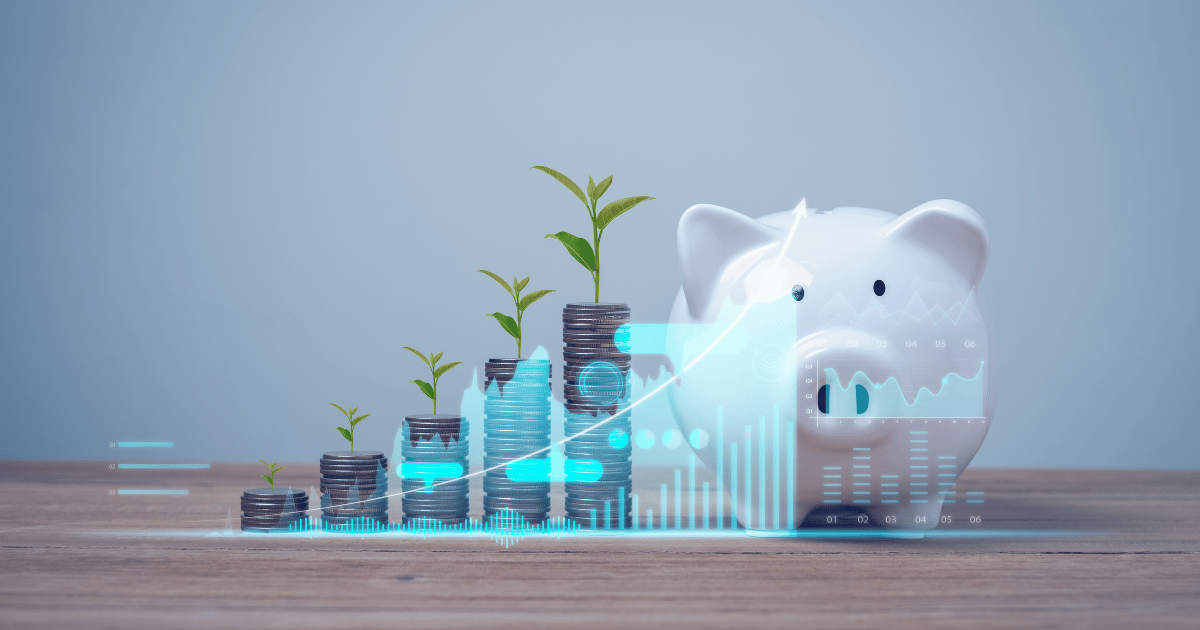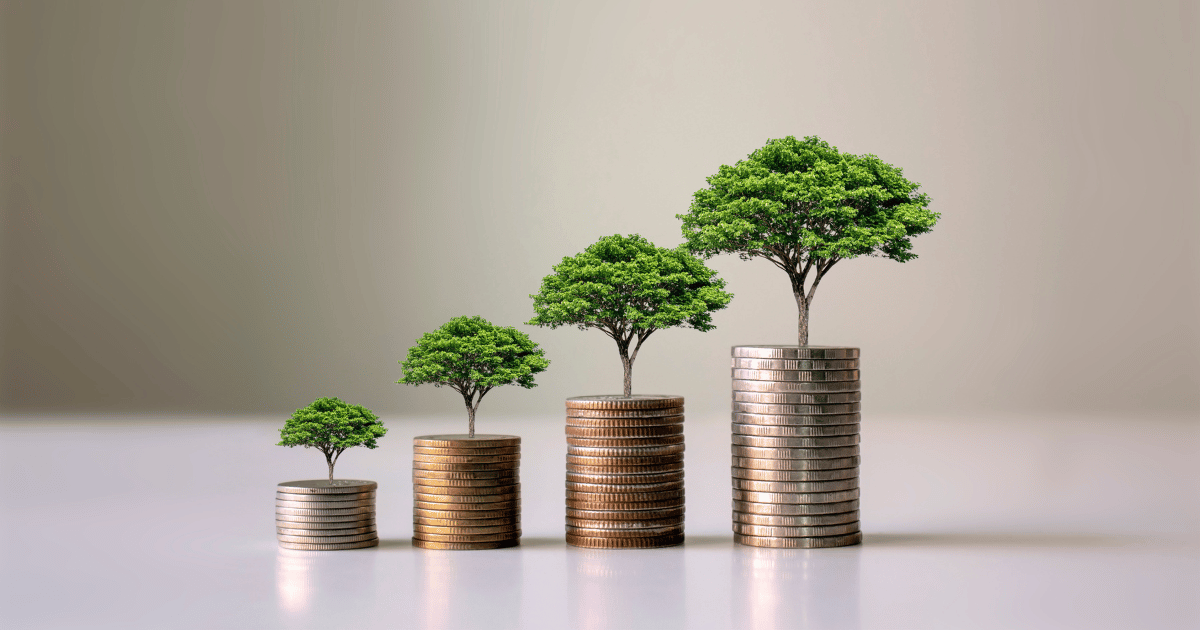How to Invest $100K to Protect and Grow Your Wealth

So you have $100,000 to invest. What now?
You should have two objectives:
- Protect the money you have
- Increase your net worth
You can achieve these objectives simultaneously by investing in the right mix of assets and constructing a portfolio tailored to your goals, financial needs, and risk tolerance.
Don't worry — it's not as complicated as it sounds.
This guide will provide you with everything you need to start building your own portfolio and putting your money to work for you, safely.
Pre-investing checklist
Here are a few questions you should answer before you make your first investment:
Do you have any high-interest debt?
Credit cards and other consumer loans tend to have very high interest rates (14–26% APR).
If you have high-interest debt, pay it off first, as it is very unlikely you will generate this high of a return from any investment.
Do you have an emergency fund?
An emergency fund is a sum of money that is kept in the bank and only used for unexpected emergencies.
Many people like to keep enough money to cover 3–6 months of expenses in their emergency fund, but you may want to add more if you have a family or variable income.
If you draw on this fund, your first priority after getting back on your feet should be to replenish it.
How do you want to allocate your investments?
Once you've eliminated any high-interest debt and established an emergency fund, you can use your remaining cash to invest.
However, how to go about that can vary. Since we all have different financial situations, obligations, goals, and risk profiles, the perfect investment allocation for you is different than it is for me.
Asset allocationThis refers to how you divide your portfolio between different asset classes like stocks, bonds, cash, and real estate. Most experts recommend diversifying your money across many assets to lower your portfolio's risk.
Here are a few questions that will help you decide which investments are right for you:
-
How old are you? If you're young and have a long investment timeline, you can gear your portfolio more heavily toward riskier assets like stocks. On the flip side, if you're nearing retirement and will need the money soon, you may want to rely on safer, income-producing investments like bonds.
-
When do you need the money? If you're young and saving for retirement, you can invest in riskier assets with more upside (like stocks) than someone who is saving to buy a house in the next year, who may invest in bonds or a high-yield savings account.
-
What are your financial obligations? In other words, how much risk can you take on? If you're a young person with no obligations and a high-paying job, you can tilt your portfolio to take on more risk than someone with a moderate-paying job, a mortgage, and kids to provide for.
-
Do you want to manage your own money? If you have no interest in managing your own money, that's okay! You can use a robo-advisor or use a service called WiserAdvisor to find a local financial advisor to manage your money on your behalf.
With those questions answered, let's start investing $100,000.
How to invest $100,000
Here are six of the most popular asset classes among investors.
To diversify properly, most experts would advise you to allocate portions of your $100K across many of these assets.
For example, I have some of my money in each of these assets, though the bulk is in #1 and #2.
1. Index funds
Index funds are one of the most popular investments in the world (and my personal favorite). An index fund is an investment that holds a preset basket of stocks based on a specific market.
The best way to invest in index funds is to buy exchange-traded funds (ETFs), which are traded like stocks but hold all the stocks in an index.
For instance, VOO is an index fund ETF that tracks the performance of the S&P 500, a collection of the largest companies in the United States.
QQQ tracks the performance of the Nasdaq 100, a collection of mostly U.S. technology stocks, and VT owns every public company in the world.
The primary benefits of owning an index fund are:
-
They're diversified: You own a large basket of stocks, which spreads your risk among many companies with a single purchase.
-
They're inexpensive: VOO has an expense ratio of 0.03%, which means it costs just $3 per year for every $10,000 you have invested.
-
They're passive investments: Since they simply track an index, these funds are extremely low maintenance, making them ideal long-term investments.
Plus, the S&P 500 index fund has consistently outperformed professional stockpickers.
Brokerage accounts
To buy index funds, stocks (#2), and bonds (#3), you'll need a brokerage account. You can open an account for free with Public.
2. Individual stocks
If you're particularly bullish on a certain company like Amazon (AMZN), Apple (AAPL), or Microsoft (MSFT), you may decide to invest in its stock.
By buying a company's stock, you become a part owner in that business.
The same is true when you buy an index fund, except you're becoming a part owner in hundreds of stocks at the same time. To make a more concentrated investment, you can buy individual stocks.
As you might imagine, buying individual stocks is less diversified — and more risky — than buying index funds, though there is also potential for big gains.
Investing in stocks requires far more skill, time, and discipline than buying index funds.
3. Bonds
You can lend your money to companies and governments via bonds. In return, you will receive interest payments plus the amount you lent when the bond matures.
Unlike stocks, the borrower is obligated to repay the loan. This makes bonds far less volatile investments than stocks.
Many investors choose to blend a portfolio of stocks and bonds. By doing so, you can add diversification, lower your volatility, and benefit from the growth potential of stocks and the regular interest payments from the bonds.
You can buy individual bonds or, if you don't want to manage individual bond positions, bond ETFs.
Some popular bond ETFs are the Vanguard Total Bond Market (BND), Vanguard Tax-Exempt Bond (VTEB), and iShares Core U.S. Aggregate Bond (AGG).
4. Cash (savings accounts, T-bills, and CDs)
Beyond stocks and bonds, cash is another popular investment.
When investors use the term “cash,” they're typically referring to any liquid, stable investment that can easily be converted into physical money.
These investments include high-yield savings accounts, short-term Treasury bills, and certificates of deposit (CDs).
I have both a high-yield savings account (you can compare accounts with Raisin) and a considerable amount of cash in my brokerage account in SGOV, a short-term Treasury bill ETF.
By allocating a portion of my portfolio to cash, I can smooth out the volatility of my stock and index fund investments.
As of the time of this writing, most investors are earning 3–4% on their cash.
5. Real estate
Next on the list of possible ways to allocate part of your $100K is real estate.
For starters, if you want to own your own home, $100K would make for a sizeable down payment in most zip codes.
However, be sure your income is high enough to support the monthly mortgage payment. I also wouldn't recommend using the full amount for a down payment if you have high-interest debt or don't have an emergency fund in place.
You could also use the money to buy an investment property, though you'll probably need more cash for that.
If you don't tick all of those boxes but still want to invest in real estate, you may consider investing on a real estate crowdfunding platform like Yieldstreet or Arrived.
6. Alternative investments
Finally, if you're interested, you may decide to allocate a small portion of your portfolio to alternative investments.
In general, these assets are more speculative in nature and are often high-risk, high-reward types of investments.
Some alternative investments you may be interested in are art (check out Masterworks), private credit (try Percent), private equity, and more.
If you want to invest in alternatives but don't know where to start, check out YieldStreet's Alternative Income Fund. The fund invests in a diversified basket of alternative investments.
The bucket strategy
Now that you know what you can invest in, you can further hone your portfolio to your specific situation based on when you'll need the money you're investing.
One easy method for doing this is lumping your investments into “buckets.”
These buckets will look slightly different depending on your age, employment status, net worth, etc., but the following example should be illustrative regardless of your exact situation:
| Bucket | Purpose | Risk level | Investment |
| Bucket #1 | Your next 6–12 months' expenses | No risk | “Cash” |
| Bucket #2 | Any big savings goals OR retirement expenses for the next 1–2 years | Low risk | Short-term bonds |
| Bucket #3 | Any big savings goals OR retirement expenses for the next 3–6 years | Medium risk | Intermediate bonds, some index funds, and stocks |
| Bucket #4 | All money to be saved for 8–10 years or longer | Higher risk | Primarily index funds and stocks |
Given the data above, if you're investing money that you won't need in the next ten years (bucket #4), index funds and stocks should make up the bulk of the weighting.
On the other hand, if you're saving for a down payment on a house that you expect to buy in under two years, that money should probably be kept in short-term bonds.
Examples of investing $100,000
To put everything you've learned so far into practice, let's imagine two hypothetical investors.
Disclaimer: For illustrative purposes only. This is not investment advice.
Investor 1: Bill
Bill is a 44-year-old who just earned a $100,000 bonus (after taxes). Bill has no dependents, no high-interest debt, and a well-funded 401(k).
Bill doesn't have an emergency fund, so he starts by putting $18,000, which covers six months of expenses, into a high-yield savings account.
Bill is slightly conservative, so he takes the remaining $82,000 and puts 45% in index funds (split evenly between VOO, QQQ, and VT), 45% in bonds (primarily 10-year Treasury bonds or IEF), and invests the remaining 10% in alternatives.
Investor 2: Maria
Maria is a 29-year-old who just received a $100,000 inheritance. Maria is married and has one child.
Maria starts by knocking out her $6,500 credit card balance and adding $34,000 to her emergency fund, which covers ten months of her family's expenses.
Like Bill, Maria has been diligent about investing in her 401(k), but she's younger and is less risk-averse than Bill.
She decides to invest the remaining $59,500 into a portfolio of 50% VOO, 40% individual stocks (which she divides across ten stocks), and 10% SGOV (short-term treasury bills).
The Barbell Investor
If you want to see how I invest my money, check out The Barbell Investor.
How to invest $100,000 for retirement
If you're wondering about the best way to invest your money for retirement, all of the above “asset allocation” recommendations remain true.
What you need to know about is “asset location,” or the types of accounts you're holding your investments within.
If you're saving money for retirement, you'll want to use retirement accounts.
To incentivize people to save for retirement, the government offers tax-advantaged accounts. These allow you to either 1) avoid taxes on contributions or 2) avoid taxes on withdrawals.
Because you can get tax breaks for using them, the government has set maximum contribution limits on each type of account.
Employer-sponsored plans
Many U.S. employers offer retirement programs for their employees. The most common example is the 401(k), though you may have a 403(b) or 457(b) if you're a teacher, work at a nonprofit, or are a government employee.
The advantage of using employer retirement accounts is that you don't have to pay income taxes on any amount you contribute or on any of the profits as the account grows.
You will only pay taxes when you withdraw the money in retirement, which will be taxed at your then current income tax rate.
The maximum annual contribution limits for these accounts are:
- In 2024: $23,000 (plus a $7,500 “catch-up” contribution for those age 50 and older)
- In 2023: $22,500 (plus a $7,500 “catch-up” contribution for those age 50 and older)
Additionally, many employers offer matching programs up to a certain percentage of your paycheck.
For example, if your employer offers 4% matching and you contribute 4% of your paycheck each month, your employer will be doubling your monthly contribution.
Individual retirement accounts (IRAs)
After contributing to the retirement plan offered by your employer (or if your company doesn't offer one), you can use an IRA.
A traditional IRA operates the same way as a 401(k) — you won't pay taxes on the contributions or growth of the account, but you will pay taxes on the withdrawals.
With a Roth IRA, you pay your taxes up front (like normal), but your money grows tax-free, and all of your withdrawals are also tax-free.
This tax treatment makes these accounts ideal for anyone who believes their income tax rate is lower now than it will be in the future, like those early on in their careers.
The maximum annual contribution limits for IRAs are:
- In 2024: $7,000 (plus a $1,000 catch-up contribution for those age 50 and older)
- In 2023: $6,500 (plus a $1,000 catch-up contribution for those age 50 and older)
Frequently asked questions
Should I invest all of my money at once?
There are two camps regarding whether or not you should invest all of your money at once, which is called “lump-sum investing.”
From a purely mathematical point of view, lump-sum investing has been proven to generate higher returns about 65% of the time.
The other option is to invest the same amount at regular intervals, known as “dollar-cost averaging.”
While dollar-cost averaging (DCA) may be suboptimal, it is an excellent way to minimize the risk of regret as it will keep you from ever investing a lump sum right before a market crash.
This is why I prefer dollar-cost averaging despite the data pointing in favor of lump-sum investing.
If you have $100,000 and want to DCA, the amount and timeline you invest is up to you. For example, you may choose to invest $10,000 once per month for ten months, or you may choose to invest $20,000 once per month for five months.
You should choose based on whatever makes you comfortable, but be sure to stick to the plan and make each purchase regardless of what's going on in the market.
How much interest will $100K earn in a year?
How much interest your $100K will earn depends on what you invest in.
A note on bonds
Bonds earn interest, while stocks generate a total return (price appreciation + dividends).
From 1928 to 2022, stocks returned 9.6% per year, while bonds yielded 4.6% per year.
Using these returns, if you had put all $100,000 in stocks or in bonds, you would have earned $9,600 or $4,600 per year, respectively. If you had invested half the money in stocks and half the money in bonds, you would have earned $7,100 per year.
How much you will get in interest will depend on your asset allocation. For example, VOO (an S&P 500 index fund) currently has a 1.4% dividend yield while SGOV (a short-term treasury bill ETF) has a yield of 4.8%.
What about taxes?
The “capital gains” tax refers to the taxes owed on the profit an investor makes from the sale of an investment.
Capital gains fall into two categories: short-term and long-term.
Short-term capital gains are owed on the profits from any investment that was sold within one year from the purchase date. The short-term capital gains rate you will owe is equivalent to your standard income tax bracket rate.
Long-term capital gains, on the other hand, are owed on the profit of any investment held for more than one year.
Long-term capital gains tax rates range from 0–20%, depending on your income.
What account types should I use?
Generally speaking, experts suggest using tax-advantaged retirement accounts (like 401(k)s and IRAs) whenever you can.
As mentioned above, these account types will give you a tax break either on the money you contribute to the account or the money you withdraw from the account.
Yet, while they will save you money on taxes if used properly, they also have restrictions and penalties for withdrawing money before retirement age.
So, if you're investing with money you're planning to use before retirement, you may want to consider using a traditional brokerage account instead of a retirement account.
Final word
There is a lot that goes into investing $100K, and this guide can only scratch the surface of everything that it entails.
If you're overwhelmed with the prospect of investing your own money, I would encourage you to look into using a robo-advisor or hiring a local financial advisor.
You'll have to pay a fee, but you may find the cost to be well worth the value you receive.
On the other hand, if you're more interested now than you were at the start of this article, you're well on your way to becoming capable of managing your own money. All you really need is curiosity and discipline.
And if you want to learn more about exactly how I invest my money, check out The Barbell Investor.


.png)



